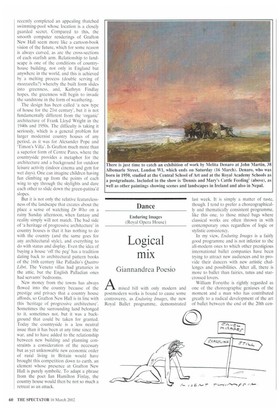Dance
Enduring Images (Royal Opera House)
Logical mix
Giannandrea Poesio
Amixed bill with only modern and postmodern works is bound to cause some controversy, as Enduring Images, the new Royal Ballet programme, demonstrated
last week. It is simply a matter of taste, though. I tend to prefer a choreographically and thematically consistent programme, like this one, to those mixed bags where classical works are often thrown in with contemporary ones regardless of logic or stylistic consistency.
In my view, Enduring Images is a fairly good programme and is not inferior to the all-modern ones to which other prestigious international ballet companies have been trying to attract new audiences and to provide their dancers with new artistic challenges and possibilities. After all, there is more to ballet than fairies, tutus and starcrossed lovers.
William Forsythe is rightly regarded as one of the choreographic geniuses of the moment and a man who has contributed greatly to a radical development of the art of ballet between the end of the 20th cen tury and the beginning of the 21st. Created in 1988. In the Middle Somewhat Elevated is without doubt one of the most representative works of Forsythe's challenge to ballet canons and conventions, as well as a visually stimulating compendium of his former creative formulae and signature features. The fast-paced action draws upon a wellthought out interaction between the purest principles of classical dance and movements that depart radically from those canons. And yet, despite this innovative approach, the work stands out for the linear clarity of its structure, in which one can easily find echoes of ballet's well-affirmed tradition.
References to the standard ballet repertoire, to its conventions and traditions are also the main ingredients of the 1996 The Vertiginous Thrill of Exactitude, a work in which Forsythe shows the best of his playful side. Without ever slipping into parody, The Vertiginous Thrill of Exactitude is a sparkling, affectionately ironic look at a glorious past underscored by a number of not always so evident innovative solutions and some diabolically demanding passages.
Having Mediterranean origins, and having grown up artistically with the formulae of what is generally referred to as the 'North European choreographic style, I haven't got the same reservations that some of my colleagues and many British dance-goers have towards the work of Spanish-born Nacho Duato, whose choreographic modes have often been compared to those of Jiri Kylian, namely the father of the North European school mentioned above. His 1997 Remanso is an eye-catching work created for an all-male trio that relies greatly on an often humorously ambiguous, but also sometimes predictable, exploration of masculinity.
For Vas Muero, on the contrary, is a rather long dance set to verses by Garcilaso de la Vega and 16th-century Spanish music. in which contemporary images are interwoven with stylised quotations from both the 15th and the 16th centuries. Spectacular as it may look, the work has not much drive and soon becomes repetitive. As such it is not an ideal way to conclude an evening. The night I went, each work was danced fairly well by a super cast that included excellent dancers such as Alina Cojocaru, Darcey Busse11, Marianela Nunez, Tamara Rojo, Johan Kobborg, Roberto BoIle, Angel Corella and Edward Watson.
• None of the interpreters of In the Middle Somewhat Elevated, however, seemed to be able to engage fully with the powerful drive of the piece and its undertones. Moments of technical untidiness appeared also in the demanding The Vertiginous Thrill of Exactitude and in Par Vos Muero. The last named work together with In the Middle Somewhat Elevated will soon be part of another composite bill which will also include Carmen by Mats Ek, which is something to look forward to.

















































































 Previous page
Previous page